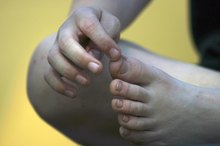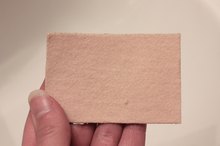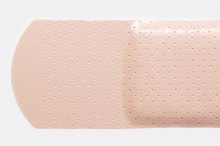How to Treat a cut on the bottom of a toe
Treating a cut on the bottom of a toe is just like treating a cut anywhere else, with one significant difference. Since so much pressure is put on them during the day, they need extra protection to keep from getting re-opened or infected. Here's how to do it.
If you are experiencing serious medical symptoms, seek emergency treatment immediately.
Examine the cut. Is it deep or shallow? Is it long or short? Is it clean, or dirty? is there anything in it? Is it bleeding and, if so, how badly.
How to Make Cuts Heal Faster
Learn More
If the cut is bleeding badly, the first matter is to stop the blood flow. Wrap a bandage moderately tightly around it, and elevate the foot by putting it up on a table or chair. Sterile gauze is the best way to stop the bleeding, but a paper towel or even a T-shirt will do in a pinch.
Once the bleeding has slowed, or if it was not bad to begin with, walk to the bathroom, taking care to put as little pressure on the wound as possible. If possible, have someone else support you so you don't have to walk on the toe.
Home Remedy for a Red & Swollen Fingernail
Learn More
Clean the cut with a cloth. Wipe gently around the surrounding area and the cut itself, cleaning away any blood or dirt. Pat it dry.
Sterilize the cut with an antiseptic. This will hurt, but you need to do it to avoid an infection. Rubbing alcohol works well. Hydrogen peroxide is excellent, but it will hurt a lot.
Put on some antibiotic ointment, such as Neosporin. Be sure to cover the cut completely.
Apply a Band-aid, or other adhesive bandage. Make sure that the pad covers the wound, and wrap the bandage all the way around the toe.
Wrap a layer of bandage tape around the bandage. This will serve to provide some added cushioning to the wound, and also stop the bandage from moving around.
Change the bandage every morning and every evening. Cut it off with a scissors, wash the wound gently, and re-apply the antibiotic ointment. Then, put on a new bandage.
Particularly if you do a lot of walking, consider wearing two pairs of socks until the cut has healed somewhat. This will cushion it, making it less likely that you will irritate and re-open it.
Warnings
If the wound gets red or purple and swollen, or starts to ooze pus, go to the doctor as soon as possible. You probably have an infection.
Related Articles
References
- Study Shows Most People Are Spreading Dangerous Bacteria Around the Kitchen and Don't Even Realize It. USDA. Jun 28, 2018.
- Surgical wound care - closed: MedlinePlus Medical Encyclopedia. MedlinePlus. Jun 11, 2018.
- Pickering D, Marsden J. Techniques for aseptic dressing and procedures. Community Eye Health. 2015;28(89):17.
- Smith SM, Zirwas MJ. Nonallergic reactions to medical tapes. Dermatitis. 2015;26(1):38-43. doi:10.1097/DER.0000000000000098
- Draelos ZD, Rizer RL, Trookman NS. A comparison of postprocedural wound care treatments: do antibiotic-based ointments improve outcomes?. J Am Acad Dermatol. 2011;64(3 Suppl):S23-9. doi:10.1016/j.jaad.2010.11.010
- Ozgok Kangal MK, Regan J-P. Wound Healing. Treasure Island, Fl: StatPearls Publishing; 2019.
Warnings
- If the wound gets red or purple and swollen, or starts to ooze pus, go to the doctor as soon as possible. You probably have an infection.
Writer Bio
Isaiah David is a freelance writer and musician living in Portland, Ore. He has over five years experience as a professional writer and has been published on various online outlets. He holds a degree in creative writing from the University of Michigan.







